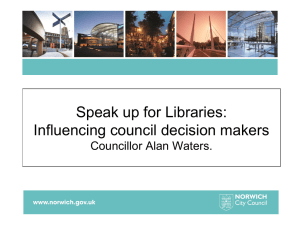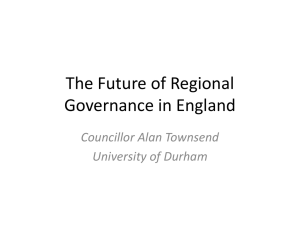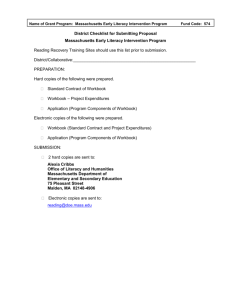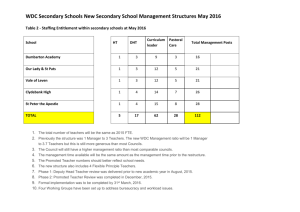Business planning and strategic management
advertisement
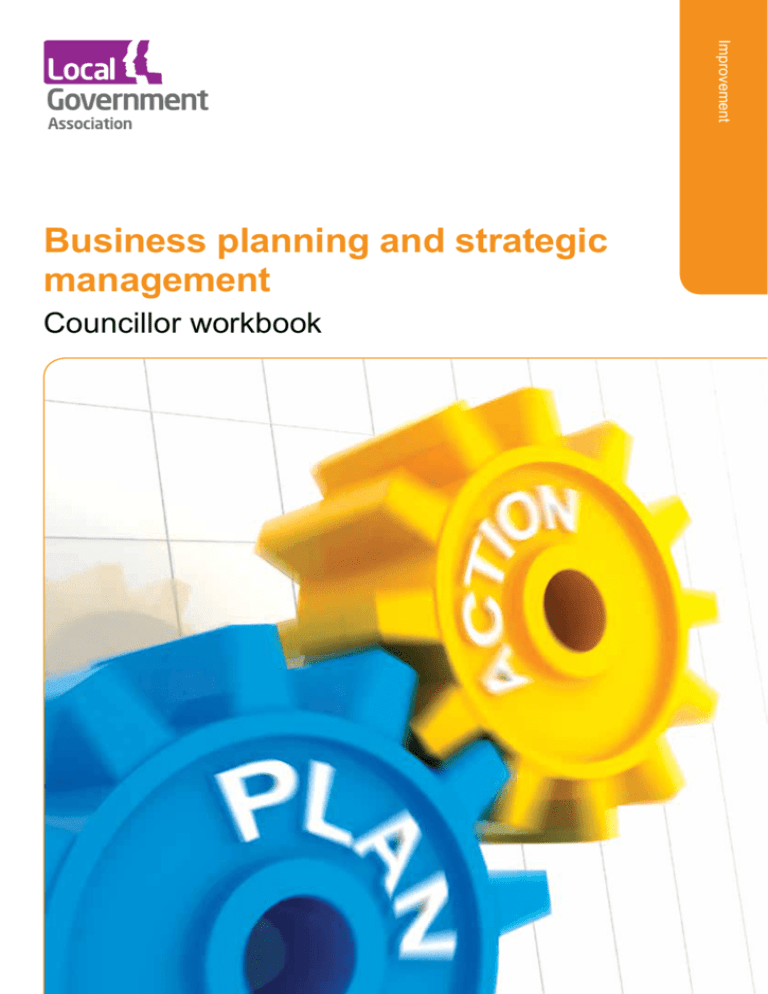
Improvement Business planning and strategic management Councillor workbook Contents Foreword3 Business planning and strategic management 5 The nature of business planning and strategic management 5 Strategic planning essentials 7 Identifying priorities 11 The context of any business and strategic plans 13 The business planning cycle 16 Scrutinising the planning process 18 Final summary 20 Appendices: A – Sources of further information and support 2 Business Planning and Strategic Management 21 Foreword This workbook has been designed as a learning aid for elected members. It makes no judgement about whether you have been a member for some time, or whether you have been elected more recently. If you fall into the former category the workbook should serve as a useful reminder of the key features of financial scrutiny. Those members who are new to local government will recognise that they have much to learn. This workbook will provide you with an understanding of the principles and practicalities of scrutinising the financial affairs of your council. The workbook offers few firm rules for ward members as it is recognised that each individual must decide how best to approach their role in relation to financial scrutiny. This will be influenced by the type of ward you represent, any specialist roles you have taken on and the nature of the financial management arrangements in your council. There is no presumption about ‘typical wards’ or ‘typical members’ and the workbook should serve more as a direction marker rather than a road map. In practical terms, the document will take between two to three hours to work through. You do not need to complete it all in one session and may prefer to work through the material at your own pace. The key requirement is to think about the issues presented and how the material relates to your local situation, the people you serve and the council you represent. Business Planning and Strategic Management 3 Introduction In working through the material contained in this workbook you will encounter a number of features designed to help you think about the nature of effective member/officer relations. These features are represented by the symbols shown below: 5 Guidance – used to indicate guidance, research, quotations, explanations and definitions that you may find helpful. Challenges – questions or queries raised in the text which ask you to reflect on your role or approach – in essence, they are designed to be thought-provokers. 6 studies – ‘pen pictures’ 1 Case of approaches used by councils elsewhere. h Hints and tips – a selection of good practices which you may find useful. i 4 Useful links – signposts to sources of further information, outside of the workbook, which may help with principles, processes, methods and approaches. A full list of useful additional information is also set out in Appendix A of the workbook. Business Planning and Strategic Management Business planning and strategic management The nature of business planning and strategic management Business planning and strategic management are as important in the public sector as they are in any other sector of the economy. Local authorities need to plan their future direction on the basis of the best strategic fit between the resources available to meet stakeholder needs and expectations and the environmental conditions which prevail. Strategies help councils to think through what they want to achieve and how they will achieve it. Putting strategies into practice and acting strategically ensures that councils are focused on the things that really matter – not buffeted by events or short-term distractions – and are able to allocate their scarce resources accordingly. This requires both vision and the ability to prioritise. A definition of terms Strategic management – the process and organisational arrangements which allow a council to plan for success over the long-term. By their nature, strategic plans tend to be complex in nature, ie multi-perspective, multi-service and multi-interest. They may require decisions to be made in the face of uncertainty or ambiguity and will certainly involve change. Business planning – the processes which allow a council’s strategic vision, objectives and priorities to be translated into operational action plans. A corporate business plan will identify what needs to happen in all service areas to achieve success, what resources will be required for delivery, the outputs and outcomes that are anticipated and any other contributory factors (eg actions by partner organisations, risks, resource assumptions etc). Underpinning this, most councils will usually have individual service plans for each defined area of council business which provide greater detail and specify a range of performance targets for those delivering services or improvements. Strategic management in local government tends to be more complex than that in the private sector. It generally involves multiple goals rather than one single bottom line and is implemented through a wide range of policies (both nationally and locally determined), laws and local services. Far from being a neat linear process, it is often shaped by unexpected events and political pressures. It also often needs to be more visible and accountable than strategy in other sectors. Business Planning and Strategic Management 5 What is strategy? “…the direction and scope of an organisation over the long-term which achieves advantage for the organisation through its configuration of resources within a changing environment and to fulfil stakeholder expectations…” Exploring Corporate Strategy, Gerry Johnson and Kevan Scholes As a rule, the best strategies in local government tend to be those that are: • Clear about goals (objectives) and relative priorities. • Underpinned by a good understanding of the changing environment in which councils are operating, eg trends in government policy, the nature of the local economy, opportunities and threats to services etc. • Based on a realistic understanding of what is possible, ie not just a strategy that works well on paper. • Developed with, and communicated to, all those with a stake in the implementation of the strategy, eg members/managers/ staff, partner organisations and community groups. • Creative – designing and discovering new possibilities and ways of working to challenge complacency and inspire innovation. 6 Business Planning and Strategic Management Exercise 1 – your council’s strategic plan(s) Using any information sources that are available to you as a member, obtain a copy of your council’s long-term strategic plan(s). If you unsure which document(s) to access, you may wish to consult your officers: (a) Is it clear to you what period of time the council’s strategy covers? (b) Does the strategy contain an overall ‘vision’ for the future (eg this may be explicitly stated as the ‘vision’ or ‘mission’ of the council or may be implied from the early wording of the document)? (c) Does the strategy identify any specific ‘aims’ or ‘objectives’? (d) Does the strategy identify a small number of stated ‘priorities’? (e) Is it clear to you how the council’s strategy links in with other strategies for the area, eg a wider ‘Community Plan’ or the strategy documents of other statutory partners (eg NHS bodies)? (f) Is it clear to you how the strategy is to be resourced (eg is there specific budgetary information within the document or reference/links to something like a medium term financial plan)? If the answers to any of the questions above are not clear, you should speak to your officers or executive members (if relevant) to find out why this is the case. These will be essential components of your council’s strategy and gaps or omissions in any of these areas may highlight weaknesses in the overall approach. Strategic planning essentials Every council has its own methods and preferences for producing both strategic and business plans. For some, the process of planning is precisely defined and imposed from the top-down according to strict guidelines and accepted business practice. For others, the formulation of strategies and plans is seen as a more evolutionary and consultative process, emerging from discussion, experimentation and learning. As a result, strategic and business (or operational) plans can vary significantly in terms of content and context. Business Planning and Strategic Management 7 An example of strategic planning The London Borough of Sutton has a corporate plan which provides a high level, strategic view of the council’s priorities and what it wants to achieve from 2011/12 to realise its vision of building a community in which all can take part and take pride. The four-year corporate plan sets out the organisation’s key priorities and the outcomes that it aims to achieve over the period of the plan, including some targets in support of the outcomes. It is framed around four key themes, eg ‘Fairer – creating a community that everyone feels part of and are able to access the services they need’. A number of strategies and plans support the corporate plan and there is a budget and delivery plan for each council group. These contain annual targets that the council uses to chart its progress towards achieving the longer-term outcomes of the corporate plan. http://tinyurl.com/csv59fd Whatever approach is taken by your council, there should be clear links between any strategic decisions that are made, the policies which the council puts into place and the resulting services delivered to local people. In effect, it should be one ‘end-to-end’ process with constant testing, feedback, learning and improvement (see diagram). The strategic planning framework Public and user feedback consultation and engagement High level goals Trends and futures Context and constraints Strategic direction Policy design Measurement and analysis testing, piloting and continuous learning Adaptability Source: Strategy Survival Guide, Cabinet Office 8 Business Planning and Strategic Management Delivery Outcomes The strategy also needs to have a clear sense of direction, based on some analysis of different strategic choices and their implications. For many councils, the practical outcome of this will be a written ‘mission’ or ‘vision’ statement, together with some ‘aims’ and short, medium or long-term ‘objectives’ that provide a coherent and consistent framework for planning ahead. Your council will also need to set priorities within its strategic and operational plans. This not only helps to demonstrate ambition and focus, but should help to ensure that limited resources are spent to best effect on the things that matter most in the council area. Local people will want the council to be economic and efficient in its use of resources, but will want it to be effective even more – and this means identifying not only ‘how to do things right’, but identifying ‘the right things to do’. A sense of direction All strategies should have a clear sense of direction, which may be based on the following: One way to think about priorities is to divide them between high-level strategic priorities (which could be included as part of your council’s ‘vision’, ‘aims’ or ‘objectives’) and operational priorities: • Strategic priorities – needed because local communities have complex and diverse needs that cannot always all be met. Councils need to work with service users, citizens and partners to identify these. • Operational priorities – needed to make clear what needs to be done to achieve the council’s objectives. They can be divided into (a) those that concern ‘business as usual’, ie they help to deliver strategic priorities but are mainly about continuing with existing activity, and, (b) those that involve new projects, programmes or activities. It needs to be made clear who will be responsible for delivering these priorities. In most cases this will be included within a business plan (or individual service plans). Over time, the council should be allocating more of its resources towards these identified priorities and away from the non-priority areas. • Vision – a mission or statement of aspirations describing a desired future. • Aims – the outcomes needed to bring about that desired future. • Objectives – those things that need to be achieved in order to realise the outcomes. Business Planning and Strategic Management 9 When is a priority not a priority? A priority is something that is considered more important than other things. It involves making a choice or choices. But when you choose something as a priority, what happens to everything else? This depends on the situation and context, eg the things you choose not to do first today, may be done second, or tomorrow – or perhaps you decide they’re not important to spend time on at all. Those things that aren’t on the priority list for a council or individual service area may still need maintaining, or maybe they can be reduced or stopped altogether. It can be as important to decide on those things that are not priorities (and what happens to them), as it is to decide on priorities. Sometimes these are called non-priorities but can also be described as being of lower preference or lower resource allocation. If all the lower preference activities continue regardless, it could put the real priorities at risk. Exercise 2 – identifying priorities Imagine that all ward members in your council have been asked to come up with some ideas for an initial ‘long list’ of potential operational priorities as part of the planning process. Identify three or four sources of information that might enable you to determine some potential priorities for consideration: Look again at your answers. You may have considered some formal sources of information (eg published statistics, performance data or relevant research) or even information on priorities identified by partner agencies (eg police, NHS or third sector organisations). However, the best source of information is likely to be your own knowledge of the area and the issues or ‘hot topics’ of greatest concern to your constituents, eg if you are receiving consistent messages about the problems caused by youth crime in your ward it would be perfectly reasonable to suggest that one potential priority area could be to ‘reduce youth crime’. At the early stage of the prioritisation process, it is important that the council considers a broad range of potential ideas as part of its planning. 10 Business Planning and Strategic Management Identifying priorities The process of developing relevant priorities can be divided into three stages: (a) identifying priorities, (b) prioritising priorities, and (c) maintaining focus. A summary of the approach is given in the table below An observation on priorities ‘If you have 25 priorities you have none...’ Jan Carlson, Scandinavian Airlines Executive Setting priorities and maintaining focus Identifying priorities Priorities can be developed from a range of sources: the local community, local intelligence, government or national bodies, and priorities generated within the council itself Engage the local community – use mechanisms for consulting and engaging with local people, eg surveys, citizens’ panels, local committees and forums. Find ways also of communicating with traditionally excluded groups, eg consulting young people through youth parliaments and online debates. These methods can help to identify issues that can become priorities, but also to gather feedback on draft priorities to make sure they are the right ones. Use local intelligence – use intelligence about the area and communities, eg statistics (such as census data) or information from partners (such as patterns of illness tracked by the NHS). Incorporate national priorities – many services have detailed improvement targets from government which should be reflected in the council’s early priority list. Identify partners’ priorities – councils should consider the priorities of their partners and find ways of identifying joint priorities. Gather internal priorities – councils will often have internal targets related to changes in their structures or the way they work, which may help them to achieve other priorities. These need to be identified when putting together the ‘long list’ of priorities. Business Planning and Strategic Management 11 Setting priorities and maintaining focus Prioritising priorities Having gone through a ‘stock take’ of priorities, councils need to put their possible priority areas into some kind of order. What do they aim to achieve and when? It is important to be realistic – can all the priorities be achieved at the same time? Maintaining focus Once priorities have been established, it is essential that the council focuses on them, and is not distracted by short-term issues, crises and new initiatives Be specific – priorities should not be broad, generic areas like ‘a cleaner, greener metropolis’. A priority might sit under this vision, but should more specific (eg ‘invest in and improve street cleaning’), and be backed up with a few targets that are measured by a limited number of performance indicators. Balance local with national priorities – once priorities have been identified the next step is to develop a balance between competing ones. Will the national ones take precedence over local ones? Align priorities with those of partners – once priorities have been prioritised, councils should work with their partners to create as wide a resource base as possible so that priorities can be met. Use council processes to ensure focus – align the portfolios of cabinet members, service plans and individual staff development plans with priorities and ensure that the performance management scheme works to deliver these. Communicate priorities – keep everyone in the council and key partnerships aware of the priorities and progress on these. Manage risks – develop methods to manage unforeseen crises or new pressures which deflect attention away from priorities. Shift resources to priorities – clarity about priorities should ease the process of shifting resources to support those priorities. Review priorities – revisit and review priorities at regular intervals, assessing progress and making changes to them as appropriate. 12 Business Planning and Strategic Management Conducted in the way suggested, the prioritisation process should provide opportunities for ward members to play a role, particularly around engaging with the local community and making best use of local intelligence. Exercise 3 – engaging your local community Using any information sources that are available to you as a member, find out what process your council went through in identifying its operational priorities: (a) What opportunities did local residents have to contribute to this process? (b) Could you suggest any ways in which ward members could assist in improving the engagement with local people when identifying future operational priorities? The context of any business and strategic plans Business and strategic plans that are not deliverable are of little use. The key aim of the planning process should be to deliver on the council’s strategic and operational objectives and make these the primary focus of the organisation. Your council’s business and strategic plans should be closely linked to the plans of the main partnerships in which the council is involved, but should also be clearly aligned with the internal processes necessary to make the objectives ‘business as usual’ for the teams and individuals delivering the services for the council. This is illustrated in the diagram overleaf: Business Planning and Strategic Management 13 Linking the strategic plan to service delivery Strategic Plan Setting out the council’s strategic vision, objectives and priorities Delivery Partnership Aims Delivery programmes agreed with partner organisations Statutory Aims Policy directives identified by central government objectives and priorities Medium Term Financial Plan How the council will resource its business and strategic plans Business Plan How the council will deliver its objectives Service Plans Operational plans for each area of council activity Individual Work Plans How individuals will contribute towards the objectives and priorities As a document, your council’s strategic plan is likely to be relatively short (perhaps no more than 15-20 pages), user-friendly and accessible, so that external audiences can understand the organisation’s strategic direction. By comparison, the business plan and linked service plans are likely to be primarily internal documents – their audience being members, managers and staff. 14 Business Planning and Strategic Management Exercise 4 – key questions for members Understanding how your council’s particular business planning and strategic management processes work in practice is crucial in enabling you to understand the likely direction of the organisation into the future. Based on the research you conducted earlier, see if you are able to answer the following questions: (a) Does the council’s planning process include the views of partners – such as other local authorities, health bodies and other agencies – and how strong in practice is the commitment to joint planning? (b) How strong are the links between business/service planning and the setting of the annual budget? (c) Is the council’s capital strategy aligned with the identified strategic and operational priorities? If the answers to any of the questions above are not clear, you should speak to your officers or executive members (if relevant) to find out why this is the case. These are important components of the planning process and gaps or omissions in any of these areas may highlight weaknesses in the overall approach. Business Planning and Strategic Management 15 The business planning cycle While custom, practice and terminology varies in every council, the annual business planning cycle is likely to cover four distinct phases of activity: and capital expenditure to align with proposed spending plans, (c) providing nominal ‘resource envelopes’ to service managers to enable them to plan within the constraints of the resources likely to be available, before the final determination of the budget, (d) the identification of draft spending plans to enable consultation on a draft budget, and (e) the formal process of agreeing the required annual budget and level of council tax for the coming financial year. • Prioritising – reviewing the strategic priorities to ensure that they remain relevant and completing a number of distinct, but interrelated, activities in identifying some supporting operational priorities. This may include an element of public and partner consultation and debates with all members and senior officers about where the focus should lie. • Delivering – the production of strategic, business and service plans is not an end in itself. The business planning cycle must then ensure that action, outputs and outcomes result from all the planning activity – this is essentially about delivering what has been agreed and checking to make sure that it has produced all of the intended benefits. The production of a strategic plan, with its vision, objectives and priorities, is likely to be a medium- to long-term undertaking, with each new plan typically covering a period of between three to five years. Business and service planning, in contrast, is likely to be conducted on an annual cycle. • Planning – this requires a corporate business plan and individual service plans to be drawn up for all defined areas of the council’s business. In some councils the business plan will cover a period of three years, with the requirement that only service plans need to be produced annually. • Resourcing – without appropriate staff, assets and financial resources, it would not be possible for a council to deliver any of its agreed objectives and priorities. The business planning cycle will therefore require consideration of five main resource elements: (a) a review of the medium term financial plan to ensure that it covers known and projected planning commitments on a rolling basis, (b) central budgeting of both revenue 16 Business Planning and Strategic Management An example of one council’s business planning cycle Business planning guidance issued Jan Feb Budget and council tax setting Mar Apr May Jun Executive agreement of draft operational priorities Jul Agreement of operational priorities Recommendations State of the district debate and public consultation events Revenue support grant Draft business plan issued Aug Sep Oct Service plan development (including risk management) Nov Draft spending plans Central budgeting Scrutinee Committee review of draft operational priorities Dec Revised business plan and service plans Resource envelopes Review of medium term financial strategy Exercise 5 – your council’s timeline Based on the research you conducted earlier, plot out, on the timeline below, when key stages of your council’s annual business planning cycle occur: Jan Feb Mar Apr May Jun Jul Aug Sep Oct Nov Dec Business Planning and Strategic Management 17 Scrutinising the planning process Scrutiny members have a key role to play reviewing and challenging all aspects of the business planning and strategic management process. Some councils have specific corporate planning scrutiny committees, which allow members to review all aspects of the annual business planning cycle and longer-term identification of strategic objectives. Others use their scrutiny function to carry out periodic or ad-hoc investigations into specific aspects of the corporate planning process. As a ward member, it is important that you use any opportunity available to you to understand and influence the strategic and operational plans of your council. Involvement in the work of the scrutiny function might help in this respect, if the option is feasible. Whatever planning approach your council adopts, there will be a number of areas which you (and, indeed, any scrutiny member) will want to review and challenge (see text box). The five principles of effective strategic planning Effective strategic planning is: Open – there is clarity about who makes decisions and how they are made, and this informs and involves key stakeholders internally and externally – members, staff, the community and partners. Anticipatory – it is forward-looking, setting aims and objectives in the context of future needs and a robust analysis of existing commitments and available resources. Intelligent – it is informed by sound information (performance, needs-based and financial) for setting priorities and for dealing with competing demands on scarce local authority resources. Coherent – it provides a framework for dealing with a range of statutory planning requirements, breaking down barriers between services and tackling crosscutting issues. Action-oriented – it links strategic decisions to implementation, through service planning, resource allocation, and monitoring and review. It promotes problem-solving and learning at all levels of the organisation. 18 Business Planning and Strategic Management Exercise 6 – the role of scrutiny Using any information sources that are available to you as a member, list below the various ways that the scrutiny function is engaged in reviewing and challenging the business and strategic plans (or planning processes) of your council: Business Planning and Strategic Management 19 Final summary Like many other organisations, local authorities are in the business of change. The complex demands placed on them by government and by the communities they serve rarely allow members or managers to be complacent or to plan on the basis of ‘no change required.’ But real change requires a sustained focus on the key priorities – in other words, what really matters to those who have a stake in effective local government. Put simply, it’s about doing fewer things well and ensuring that your council has a clear sense of direction and is better able to resist being deflected and distracted by the typical ups and down of change. Where do you go from here? Look back over the earlier sections of this workbook and consider the following: (a) What further action can you identify to improve the way that you get involved in the business planning and strategic management processes of your council, ie what things might you start doing, keep doing or stop doing? (b) Have you identified any further gaps in your knowledge or shortcomings in your personal skills? If so, please set these out below and identify any further training or development that could help, eg further reading, courses, coaching, mentoring, work shadowing etc. 20 Business Planning and Strategic Management Appendix A Sources of further information and support Publications ‘Exploring Corporate Strategy (Seventh Edition)’, Gerry Johnson & Kevan Scholes, Financial Times/Prentice Hall, 2006. ‘Exploring Public Sector Strategy’, Gerry Johnson & Kevan Scholes, Financial Times/Prentice Hall, 2000. ‘People, Places, Power: How Localism and Strategic Planning Can Work Together’, Local Government Information Unit, 2010. Useful websites www.local.gov.uk The LGA website is an invaluable source of help and advice for all those in local government. Business Planning and Strategic Management 21 Notes 22 Business Planning and Strategic Management Local Government Association Local Government House Smith Square London SW1P 3HZ Telephone 020 7664 3000 Fax 020 7664 3030 Email info@local.gov.uk www.local.gov.uk © Local Government Association, August 2012 For a copy in Braille, larger print or audio, please contact us on 020 7664 3000. We consider requests on an individual basis. L12-452
